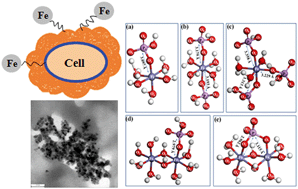当前位置:
X-MOL 学术
›
Environ. Sci.: Nano
›
论文详情
Our official English website, www.x-mol.net, welcomes your feedback! (Note: you will need to create a separate account there.)
Probing the biotransformation of hematite nanoparticles and magnetite formation mediated by Shewanella oneidensis MR-1 at the molecular scale†
Environmental Science: Nano ( IF 7.3 ) Pub Date : 2017-11-03 00:00:00 , DOI: 10.1039/c7en00767a Hong-Wei Luo 1, 2, 3, 4, 5 , Xin Zhang 1, 2, 3, 4, 5 , Jie-Jie Chen 1, 2, 3, 4, 5 , Han-Qing Yu 1, 2, 3, 4, 5 , Guo-Ping Sheng 1, 2, 3, 4, 5
Environmental Science: Nano ( IF 7.3 ) Pub Date : 2017-11-03 00:00:00 , DOI: 10.1039/c7en00767a Hong-Wei Luo 1, 2, 3, 4, 5 , Xin Zhang 1, 2, 3, 4, 5 , Jie-Jie Chen 1, 2, 3, 4, 5 , Han-Qing Yu 1, 2, 3, 4, 5 , Guo-Ping Sheng 1, 2, 3, 4, 5
Affiliation

|
Although the existence of Fe(III) (hydr)oxide nanoparticles (NPs) in natural environments has been recently recognized, their migration and transformation, which are substantially affected by the microbial reduction process, remain unclear. In this study, hematite bioreduction and magnetite formation induced by Shewanella oneidensis MR-1, a typical metal-reducing bacterial strain, were investigated using an integrated approach that combined experiments and computational simulations at the molecular scale. High-resolution transmission electron microscopy coupled with selected area electron diffraction (SAED), Raman spectroscopy and magnetic property analyses confirmed the biogenic magnetite formation. The electron paramagnetic resonance (EPR) spectra show a decay of the EPR intensity with incubation time, implying that the biotransformation of hematite to magnetite led to concurrent changes in their contents and local structures. X-ray absorption fine spectroscopy (XAFS) identified a time-resolved structural evolution of Fe(II)/Fe(III) coordination. The octahedral configuration upon Fe(II) production was subsequently validated by DFT calculations. Microbial reductive dissolution provided various intermediate states and new chemical environments regarding Fe(II)/Fe(III) complexes, such as monodentate and bidentate coordination patterns. Bioreduction caused the breakage of iron–oxygen bonds in hematite and the concomitant formation of Fe complexing microstructures for biogenic magnetite production. All these findings reveal the underlying mechanisms for the biotransformation of Fe minerals at the molecular scale and may allow us to better understand the speciation, immobilization and bioavailability of hematite NPs in natural systems.
中文翻译:

在分子尺度上 探索由沙瓦氏假单胞菌MR-1介导的赤铁矿纳米粒子的生物转化和磁铁矿形成†
尽管最近已经认识到在自然环境中存在Fe(III)(氢)氧化物纳米颗粒(NPs),但是它们的迁移和转化受到微生物还原过程的严重影响,目前尚不清楚。本研究研究了印度希瓦氏菌引起的赤铁矿生物还原和磁铁矿形成。MR-1是一种典型的金属还原细菌菌株,采用整合方法进行了研究,该方法结合了分子规模的实验和计算模拟。高分辨率透射电子显微镜与选择区域电子衍射(SAED),拉曼光谱和磁性能分析相结合,证实了生物磁铁矿的形成。电子顺磁共振(EPR)光谱显示,随着培养时间的延长,EPR强度会下降,这意味着赤铁矿向磁铁矿的生物转化导致其含量和局部结构同时发生变化。X射线吸收精细光谱法(XAFS)确定了Fe(II)/ Fe(III)配位的时间分辨结构演化。Fe(II上的八面体构型)的生产随后通过DFT计算进行了验证。微生物还原溶解提供了关于Fe(II)/ Fe(III)配合物的各种中间状态和新的化学环境,例如单齿和双齿配位模式。生物还原导致赤铁矿中铁-氧键的断裂,并随之形成了用于生物磁铁矿生产的铁络合微结构。所有这些发现揭示了分子水平上铁矿物质生物转化的潜在机制,并且可能使我们能够更好地了解天然系统中赤铁矿NP的形态,固定化和生物利用度。
更新日期:2017-11-03
中文翻译:

在分子尺度上 探索由沙瓦氏假单胞菌MR-1介导的赤铁矿纳米粒子的生物转化和磁铁矿形成†
尽管最近已经认识到在自然环境中存在Fe(III)(氢)氧化物纳米颗粒(NPs),但是它们的迁移和转化受到微生物还原过程的严重影响,目前尚不清楚。本研究研究了印度希瓦氏菌引起的赤铁矿生物还原和磁铁矿形成。MR-1是一种典型的金属还原细菌菌株,采用整合方法进行了研究,该方法结合了分子规模的实验和计算模拟。高分辨率透射电子显微镜与选择区域电子衍射(SAED),拉曼光谱和磁性能分析相结合,证实了生物磁铁矿的形成。电子顺磁共振(EPR)光谱显示,随着培养时间的延长,EPR强度会下降,这意味着赤铁矿向磁铁矿的生物转化导致其含量和局部结构同时发生变化。X射线吸收精细光谱法(XAFS)确定了Fe(II)/ Fe(III)配位的时间分辨结构演化。Fe(II上的八面体构型)的生产随后通过DFT计算进行了验证。微生物还原溶解提供了关于Fe(II)/ Fe(III)配合物的各种中间状态和新的化学环境,例如单齿和双齿配位模式。生物还原导致赤铁矿中铁-氧键的断裂,并随之形成了用于生物磁铁矿生产的铁络合微结构。所有这些发现揭示了分子水平上铁矿物质生物转化的潜在机制,并且可能使我们能够更好地了解天然系统中赤铁矿NP的形态,固定化和生物利用度。


























 京公网安备 11010802027423号
京公网安备 11010802027423号